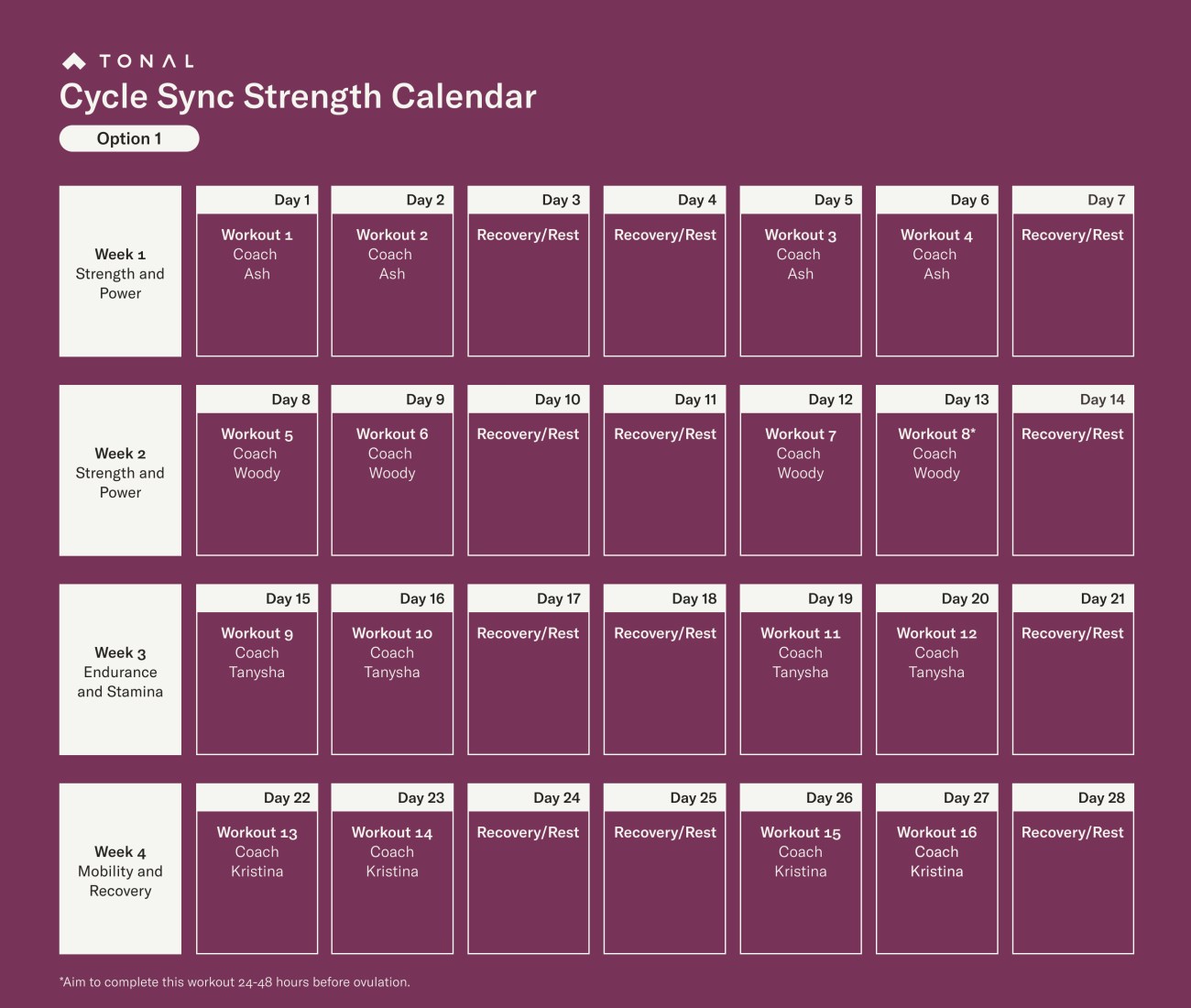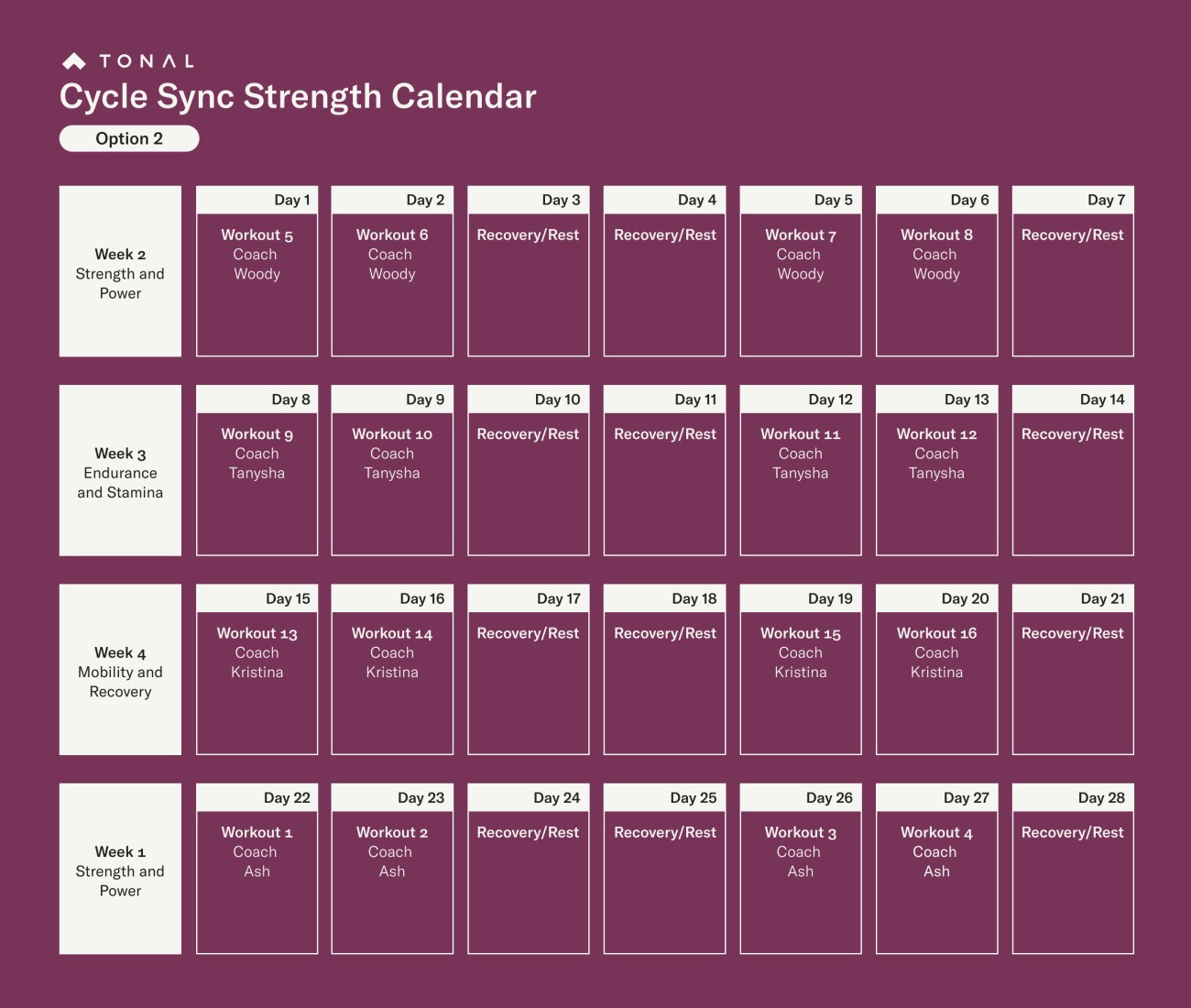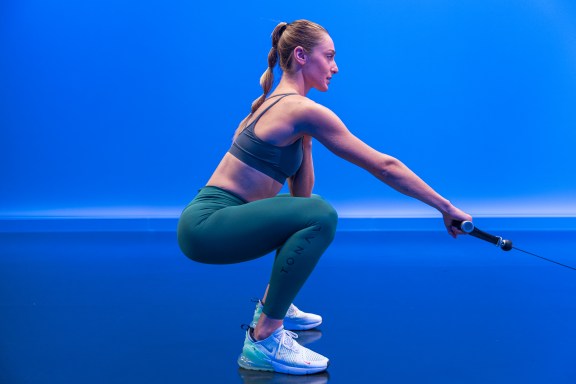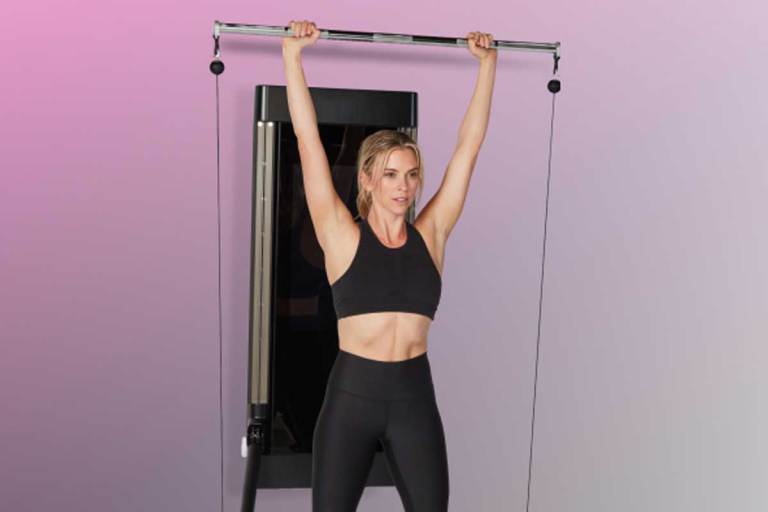Make Your Cycle Your Superpower With Cycle Sync Strength
Break through plateaus, reach new PRs, and reduce injury risk by training with your menstrual cycle.

Every time you do a coach-led workout on Tonal, you’re completing a specific series of exercises in a particular order designed by world-class fitness experts and credentialed coaches to maximize your results. In this series, The Why Behind the Workout, we break down the science behind a particular workout or program.
Here, we go deep on Cycle Sync Strength, a four-week program developed in collaboration with leading female physiology expert Stacy Sims, PhD, and led by four female Tonal coaches: Ash Wilking, Kendall Wood, Tanysha Renee, and Kristina Centenari.
Who It’s For
Cycle Sync Strength is designed for people with periods looking to make the most of their training. Whether you ovulate naturally, use oral contraceptives, or have an IUD, you can make this program work for you.
This is an advanced-level program, and you should have some lifting experience before starting.
The Goal
During your menstrual cycle, levels of the hormones estrogen and progesterone fluctuate. In addition to their reproductive functions, these hormones affect numerous aspects of training including muscle protein synthesis, stress resilience, recovery, and strength and power development.
By aligning your workouts to these hormonal changes, the Cycle Sync Strength program is designed to optimize your training by working with your cycle—not against it. You’ll push for strength and power PRs when your body is most resilient and primed for muscle development, and focus on endurance and recovery on the days when you’re lower on energy and less capable of handling stress.
As a result, you’ll be able to make bigger gains in your training and lower your risk of injury. It’s important to note, though, that training is different from performance. You can give your best performance in a race or competition at any point in your cycle. Training with your cycle is simply a way to get more out of your training by taking advantage of hormonal changes.
How It Works
To train with your menstrual cycle, you’ll need a brief understanding of its different phases and how hormone levels change. The first day of your period marks the start of your cycle and the beginning of the follicular phase. During this time, hormone levels are relatively low.
In the days leading up to ovulation (the release of an egg from your ovary, typically on day 14 of your cycle), estrogen levels begin to climb and reach a peak. After ovulation, the luteal phase begins. In this phase, levels of both hormones rise before dropping off for the cycle to begin again.

Weeks one and two of Cycle Sync Strength coincide with the follicular phase when estrogen and progesterone levels are both low, and you’re most primed for stress, recovery, and adaptation. “From a physiological standpoint, when those hormones are low, we are able to really hit high intensities,” says Sims. “We have more carbohydrates available for hitting those high intensities, and we have more water available for sweating so we have better thermal regulation.”
To take advantage of those benefits, you’ll concentrate on strength and power in these workouts with an emphasis on low-rep/heavy-resistance sets, high-intensity intervals, and plyometrics. Now’s the time to max out the power meter and give your 10 out of 10 effort in intervals. According to Jenna Moore, a certified strength and conditioning coach and Programming Specialist at Tonal, these are the “hardest-hitting weeks” of the program.
If you feel fatigued or achy at the start of your period, don’t hesitate to turn on recovery weights in the first couple of workouts. Sims explains, though, that high-intensity work actually boosts anti-inflammatory and antioxidative responses, which can reduce cramping and pain.
Although estrogen begins to rise toward the end of the follicular phase, estrogen on its own is anabolic (meaning it promotes muscle growth) according to Sims, so you’ll see a decrease in reps and an increase in load during week two for more strength gains.
The training focus switches in week three following ovulation as you enter the luteal phase. “The body starts to shift from relying primarily on carbohydrates for fuel to relying on fat,” says Moore. She explains that while carbohydrates are excellent a fueling short bursts of high-intensity activity, fat takes longer to break down and, therefore, is best suited for sub-maximal effort activities.
Therefore, these workouts emphasize endurance and stamina instead of all-out efforts that are more stressful and difficult to recover from. That means higher reps, lighter load, and longer but less intense intervals. Progesterone, which Sims explains is catabolic, meaning it breaks down lean muscle mass, also rises during this phase making strength adaptations more difficult. She says that keeping the intensity moderate this week lowers cortisol levels, inhibiting muscle breakdown.
In the final week of the program, hormone levels peak and then begin to drop, which can make you feel sluggish and cause PMS symptoms. Since your stress resilience is at its lowest and your inflammation levels are high, this week serves as a deload with workouts that include mobility exercises, unilateral moves for building symmetry, and lifts with recovery weights. Light movement during this week can help you feel better without putting unnecessary stress on your body.
The work you do in improving your range of motion, joint mobility, and balance during this phase will benefit your performance in heavy lifts later on. “There’s some skill acquisition you’ll do this week which is great because it’s not as taxing from a strength perspective,” says Moore, “but then you can take those new skills into your next phase.” You’ll finish the week feeling rested, recovered, and ready to push hard when your cycle begins again.
If you still feel like you can hit big PRs during weeks three and four, go for it. Everyone responds differently to hormonal fluctuations, and ultimately you’re the one in charge. “There’s power in knowing your cycle and knowing the [typical] reaction to those phases, but there’s also power in being attuned to your body, listening to your body, and paying attention to the symptoms that you have,” says Moore.
The Key Moves
Week 1: Barbell Sumo Deadlift

Big, heavy compound lifts are a staple of week one, which is led by Coach Ash Wilking, and the barbell sumo deadlift (her personal favorite) is no exception.
Since you’re primed for serious strength and power gains during this week, you’ll do this move with Chains mode activated to emphasize acceleration and power generation. It’s part of a power block full of other challenging lower-body moves that’ll fire up your legs and glutes.
Week 2: Barbell Squat to Press

Coach Kendall Wood leads the workouts in week two, and she says this “powerhouse” move is perfect for tapping into your capacity for high-intensity work in the mid-follicular, low-hormone phase of your cycle. It’s also done with Chains mode for maximum power development.
“It’s a great exercise for drilling the connection between the lower and upper body, generating power from the legs to transfer it to the core and arms,” she says. “The barbell squat to press not only makes you more aware of the kinetic chain and the power it holds but also makes you feel like a badass.”
Week 3: Resisted DNS Star

The workouts in week three, led by Coach Tanysha Renee, are slightly less intense than in weeks one and two, but the movements are still challenging. She loves this exercise that trains hip abduction, which is essential for moving your legs away from the midline of your body.
“Say hello to healthy hips and knees for greater ease of walking, running, and getting out of bed,” says Renee. “You also activate the core and the muscles that support the spine for improved posture.”
Week 4: Single-Arm Rotational Punch

During the high-hormone luteal phase when you’re least resilient to stress, week four is all about movement quality and mobility. While you won’t be lifting as much resistance in these workouts, which are led by Coach Kristina Centenari, you’ll be priming your body to go heavy again once hormone levels drop.
“It’s a move that’s not going to be loaded too heavily–perfect for my deload week–but still allows you to work through some sort of loaded spinal rotation,” she says. “This is so important for the overall health of our spine, and we don’t do it enough.”
When to Do It
With this program, timing is crucial for lining up the workouts with the phases of your cycle. Tracking your period and estimating when you ovulate will help with scheduling your workouts.
Cycle Sync Strength consists of 16 workouts meant to be completed over the course of four weeks (four workouts per week) or 28 days, the length of an average menstrual cycle. Generally, you’ll start the program on the first day of your period. If you are on oral contraceptives, you’ll start with Week 2 Day 1 (Workout 5) on the first day of your pill pack and complete the weeks in this order: 2, 3, 4, 1.
If you ovulate naturally (that is, you’re not on oral contraceptives), you’ll want to complete the last workout of week 2 (Workout 8) 24-48 hours before ovulation. Because most cycle length variation occurs during the follicular phase, you may have to spread out or compress the workouts in the first two weeks of the program if you have an especially long or short cycle. That might mean taking an extra rest day if you have a longer cycle, or skipping a workout if you have a shorter cycle.
As for what to do on your program off-days, Moore says it’s best to rest or consider gentle recovery sessions since these workouts are demanding. If you’re experiencing any PMS symptoms, try Yoga for PMS. With light movement and focused breathing, this session is designed to ease cramps, bloating, and lower back pain.
Refer to the two calendars below to see how to fit these workouts into your schedule.
Cycle Sync Strength Calendar Option 1
Use this calendar if any of the following apply:
- You ovulate naturally.
- You’re not on combination oral contraceptives (pills that contain estrogen and progestin).
- You’re on a progestin-only oral contraceptive.
- You have a copper or non-hormonal IUD.
- You’ve started ovulating naturally with a progestin-only IUD (typically 8 months after insertion).
In this calendar, Day 1 represents the first day of your period. Aim to complete Workout 8 24-48 hours before ovulation.

Cycle Sync Strength Calendar Option 2
Use this calendar if you are on combination oral contraceptives (pills with estrogen and progestin). The main difference with this calendar is you will start the program with Week 2 Day 1 (Workout 5).
In this calendar, Day 1 represents the first day of your pill pack.

What’s Next
Continue reaping the benefits of training with your cycle by selecting workouts and programs that align with your hormones. Moore recommends stacking these two two-week programs, the first focuses on power (good for weeks one and two of your cycle) and the second emphasizes movement quality (for weeks three and four).
Power Gains – Coach Tim Landicho

Ideal for the first two weeks of your cycle, this program will help you push through plateaus and hit new PRs in your heavy lifts. In these workouts, you’ll perform the same movement with Eccentric mode to build strength and Chains mode to develop power.
Fun and Functional Strength – Coach Kristina Centenari

Similar to the final two weeks of Cycle Sync Strength, this program stresses endurance and movement quality over high-intensity work. Centenari guides you through foundational strength training exercises (including squatting, hinging, pushing, and pulling) so you can improve your technique, and then challenges you with more complex variations.



